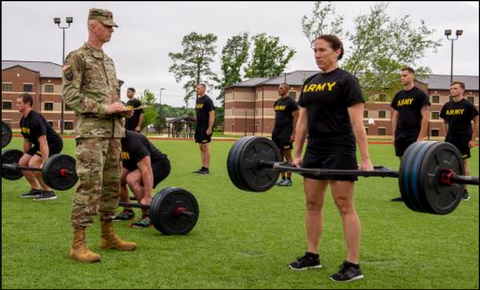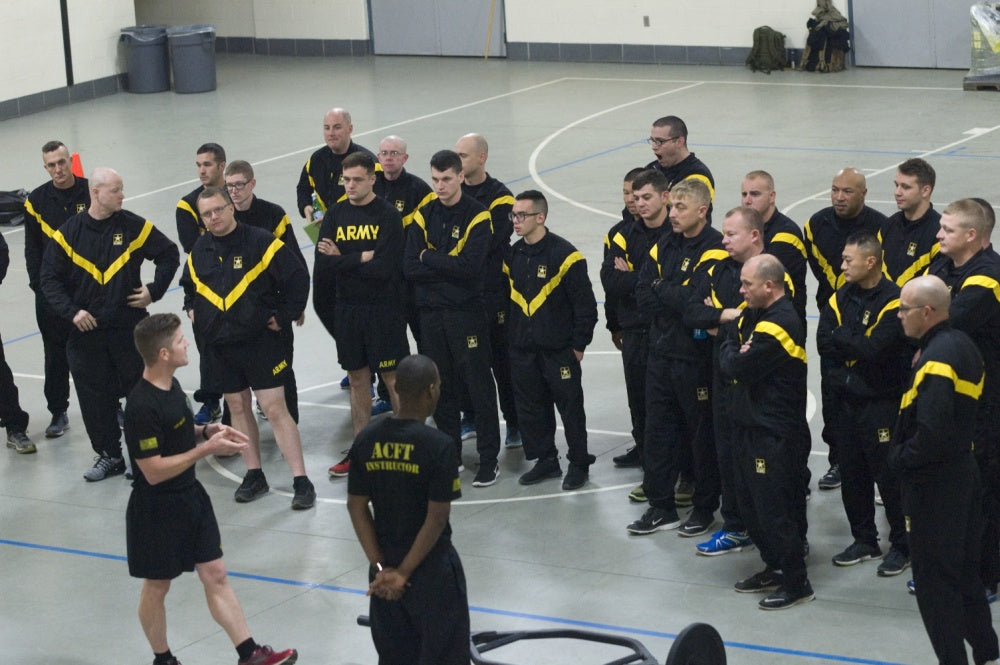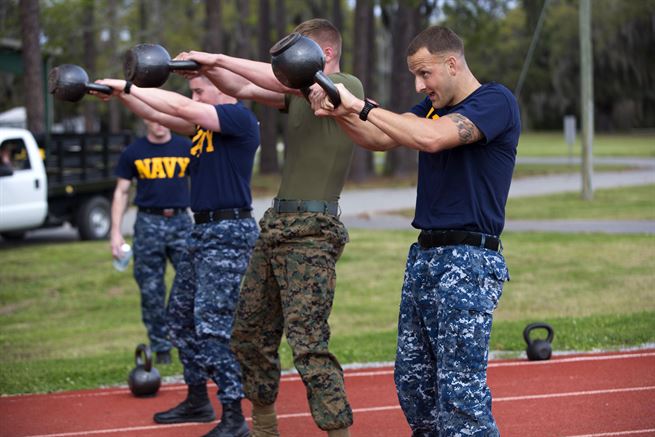- Continue Shopping
- Your Cart is Empty
Concerns About Spread of Coronavirus Delays Roll-Out of Army Combat Fitness Test

Those soldiers who have been sweating (or perhaps not sweating enough!) the implementation of the new Army Combat Fitness Test (ACFT) got a reprieve recently. Army leadership has suspended its plan to start using this more demanding gauge as its test of record this October.
Why? The mitigation and prevention of the coronavirus spread among soldiers precludes training and testing, at least for the immediate future.
According to this article, “Gym closures across installations, squad-level PT and strict adherence to social distancing guidelines make large gatherings for even the current Army Physical Fitness Test impractical,” explained Lt. Col. Robin Ochoa. “All current passing APFT scores will be extended until further notice.”
All ACFT diagnostic tests, which the entire force was scheduled to take before it officially rolled out in the fall, are also suspended. The timeline for when the new Army Combat Fitness Test will officially arrive has not yet been issued.
RALLY FITNESS HAS DEVELOPED AN ARMY COMBAT FITNESS TEST EQUIPMENT PACKAGE. Get more information on the Army Combat Fitness Test Equipment Set here.
More Equipment is Needed for the ACFT
As we have reported in this blog, the Army planned to transition fully to the ACFT at the start of fiscal year 2021. This new, more rigorous test includes the following elements:
STRENGTH DEADLIFT
With a proposed weight range of 120 to 420 pounds, the deadlift event is similar to the one found in the Occupational Physical Assessment Test, or OPAT, which is given to new recruits to assess lower-body strength before they are placed into a best-fit career field. The ACFT will require soldiers to perform a three-repetition maximum deadlift and the weights will be increased. This event replicates picking up ammunition boxes, a wounded battle buddy, supplies or other heavy equipment on the battlefield.
STANDING POWER THROW
 Participants will toss a 10-pound ball backward as far as possible to test muscular explosive power. This replicates that which is needed to lift themselves or a fellow soldier up over an obstacle or to move rapidly across uneven terrain.
Participants will toss a 10-pound ball backward as far as possible to test muscular explosive power. This replicates that which is needed to lift themselves or a fellow soldier up over an obstacle or to move rapidly across uneven terrain.
HAND-RELEASE PUSHUPS
In this event, soldiers start in the prone position and execute a traditional pushup, but when at the down position they release their hands and arms from contact with the ground and then reset to do another pushup. This is designed to build additional upper body muscles.
SPRINT/DRAG/CARRY
 As they dash 25 meters, five times up and down a lane, soldiers will perform sprints, drag a sled weighing 90 pounds, and then hand-carry two 40-pound kettlebell weights. This test simulates pulling a battle buddy out of harm's way, moving quickly to take cover, or carrying ammunition to a fighting position or vehicle.
As they dash 25 meters, five times up and down a lane, soldiers will perform sprints, drag a sled weighing 90 pounds, and then hand-carry two 40-pound kettlebell weights. This test simulates pulling a battle buddy out of harm's way, moving quickly to take cover, or carrying ammunition to a fighting position or vehicle.
LEG TUCK
 This test is similar to a pull-up, Soldiers lift their legs up and down to touch their knees/thighs to their elbows as many times as they can. This exercise strengthens the core muscles since it doubles the amount of force required compared to a traditional sit-up.
This test is similar to a pull-up, Soldiers lift their legs up and down to touch their knees/thighs to their elbows as many times as they can. This exercise strengthens the core muscles since it doubles the amount of force required compared to a traditional sit-up.
2-MILE RUN
This is the same event as on the current test. In the ACFT, run scores are expected to be a bit slower due to all of the other strenuous activity.
The now delayed ACFT is designed to better measure the physical fitness attributes soldiers need for combat, but the new six-event test required far more equipment than the older APFT.
In announcing the delay in implementation, the Army spokesman noted that soldiers taking the ACFT need hexagon bars and bumper plates for deadlifts, weighted sleds, medicine balls, kettlebells and measuring tape. The surfaces of all of these can be a transmission base for the COVID-19 virus and potentially spread it to all soldiers who use the equipment. The old test, by comparison, just required repetition counters, a stopwatch and a running path.
GET STARTED NOW!

The Army H2F Initiative: Training Soldiers Physically, Mentally and Spiritually

Professional soldiers will soon get the kind of mental and emotional support and training that professional athletes receive, as the Holistic Health & Fitness (H2F) program picks up momentum.
According to the U.S. Army, “H2F is a comprehensive, integrated, and immersive health and fitness system that generates lethal soldiers who are physically, mentally, and spiritually ready to engage with and overmatch the enemy in multi-domain operations. The system accomplishes this by addressing the physical and non-physical components of fitness through performance professionals, programs, facilities, equipment, and education. H2F improves both individual soldier readiness and unit cohesion by enhancing unit integrity.”
This program in following closely on the heels of the introduction of a more rigorous fitness test - The Army Combat Fitness Test (ACFT)
Rally Fitness Has a Long History of Improving Military Fitness
Rally Fitness has developed an Army Combat Fitness Test Equipment Package. For more information on the ACFT package, just click here.
Training for More than “Beach Muscles”
While preparations for rolling out the new ACFT in October 2020, the Army Forces Command has selected 30 battalions to train with a select group of holistic health and fitness professionals, to see what kind of support units it will need not only to implement a new PT test, but to build combat effectiveness and reduce injuries to the degree the Army is looking for with its this H2F initiative.
“In the Army, we all like to train our beach bodies," Maj. Gen. Malcolm Frost, head of the Center for Initial Military Training, said at the AUSA annual meeting in Washington, D.C.
For example, the ever - popular chest and arms.
“What we do not train is the posterior muscle groups and our core, and that’s why so many soldiers have shoulder injuries, knee injuries, lower back and hip injuries — because we have not trained our bodies for the life of a soldier,” he added.
According to this article “Ideally, over the next decade, the Army hopes to build Soldier Performance Readiness Centers, complete with an ACFT field, a terrain run park and facilities to practice with weights, kettlebells and medicine balls.

“Those centers will also have experts on site to support soldiers in a diet and exercise plan.”
In order to ensure that leaders from the bottom to the top are in synch with these fitness principles, professional military education at every level will include more advanced instruction on holistic health and fitness.
The article concludes, “For example, a soldier will learn the basics of healthy behaviors and movement in their basic training or basic officer courses, then work their way up. Exercise science will be part of the curriculum at the Basic Leader Course for future sergeants, while officers at the Pre-Command Course will learn to plan, budget and assess their own H2F programs.”
The Research Component of H2F is Critical
On April 30 - May 1, 2019, Rally Fitness and other well-known suppliers of Army fitness equipment participated in the first “H2F Industry Day and Exposition,” held at Fort Eustis in Newport News, Virginia. This two-day event featured an Industry Day with speakers from The U.S. Army Center for Initial Military Training (USACIMT) and U.S. Army Training and Doctrine Command (TRADOC), followed by an Exposition of related technologies fulfilled by Industry partners.
This Industry Day featured presentations from subject matter experts from each of the six categories of research
The Six Categories of Research Include:
- “Smart” Training Equipment
- Performance Assessment and Data Analysis
- Physical Equipment and Storage Solutions
- Cognitive Enhancement
- Injury Prevention and Mitigation
- Nutrition/Dietetics
Get more information on the Army Combat Fitness Test Equipment Set here.
GET STARTED NOW!

New Army Combat Fitness Test (ACFT) Training Website Announced

Field-testing continues on the new, more challenging fitness test for the United States Army. It is designed to better prepare soldiers of both genders for combat tasks, reduce injuries and lead to ample cost savings across the service. The six-event readiness assessment, called the Army Combat Fitness Test (ACFT), will replace the current three-event Army Physical Fitness Test, which has been around since 1980.
The Army is currently conducting a pilot with 63 battalions to determine scoring standards or any tweaks needed to make the test more feasible. Leaders can choose to implement the program Army-wide as soon as October of 2019, but as late as October 2020. As a part of getting soldiers and fitness instructors prepared for this test, the “Center for Initial Military Training” has announced the launch of a new website.
According to Army Times, “The site walks users through an implementation timeline, then lays out all six events. You can watch a video of each exercise as it’s performed on the test, plus three more with alternatives you can practice in the gym ― or in your living room ― to train the same muscles used in the test.”
The training site can be explored by clicking here.
Rally Fitness Has a Long History of Helping Military Personnel Get Stronger

In response to this change in the Army fitness test and the training that will be necessary for soldiers to meet these rigorous requirements, Rally Fitness has developed an Army Combat Fitness Test Equipment Package. This package was designed by Rally Fitness, known for its rugged CrossFit and high-use fitness facilities equipment, to help soldiers train and test administrators to accurately assess the fitness of Army soldiers.
If you would like more information on the Rally Fitness Army Combat Fitness Test Equipment Package, click here for more information.
The Army Combat Fitness Test has been noticed and commented on by non-military fitness instructors. Here are some responses posted on the social media site Facebook after this test was featured on a recent post.
“This is long past due and will improve the confidence of both the soldiers and the citizens they protect. Well done Army!”
~ Brian, CrossFit trainer in Dallas
“In theory this is a great advance for the military. I worry a little about the injuries that might occur while training for and completing the test. Some of these tests require some skill and good form in order to avoid muscle strains and other injuries.”
~ Rachel, Fitness Instructor New Orleans
Six Events That Will Challenge Every Soldier’s Mettle
Strength Deadlift
With a proposed weight range of 120 to 420 pounds, the deadlift event is similar to the one found in the Occupational Physical Assessment Test, or OPAT, which is given to new recruits to assess lower-body strength before they are placed into a best-fit career field. The ACFT will require soldiers to perform a three-repetition maximum deadlift and the weights will be increased. This event replicates picking up ammunition boxes, a wounded battle buddy, supplies or other heavy equipment on the battlefield.
Standing Power Throw

Participants will toss a 10-pound ball backward as far as possible to test muscular explosive power. This replicates that which is needed to lift themselves or a fellow soldier up over an obstacle or to move rapidly across uneven terrain.
Hand-Release Pushups
In this event, soldiers start in the prone position and execute a traditional pushup, but when at the down position they release their hands and arms from contact with the ground and then reset to do another pushup. This is designed to build additional upper body muscles.
Sprint/Drag/Carry


As they dash 25 meters, five times up and down a lane, soldiers will perform sprints, drag a sled weighing 90 pounds, and then hand-carry two 40-pound kettlebell weights. This test simulates pulling a battle buddy out of harm's way, moving quickly to take cover, or carrying ammunition to a fighting position or vehicle.
Leg Tuck
This test is similar to a pull-up, Soldiers lift their legs up and down to touch their knees/thighs to their elbows as many times as they can. This exercise strengthens the core muscles since it doubles the amount of force required compared to a traditional sit-up.
2-mile run
This is the same event as on the current test. In the ACFT, run scores are expected to be a bit slower due to all of the other strenuous activity.
The Army notes that “the ACFT gauges soldiers on the 10 components of physical fitness: muscular strength and endurance, power, speed, agility, aerobic endurance, balance, flexibility, coordination and reaction time. The current test only measures two: muscular and aerobic endurance.
Field testing will help determine scoring but it will likely be 100 points for each event for a maximum of 600. Minimum scores, however, may change depending on a soldier's military occupational specialty. Soldiers in more physically demanding jobs may see tougher minimums, similar to how OPAT evaluates new recruits.





